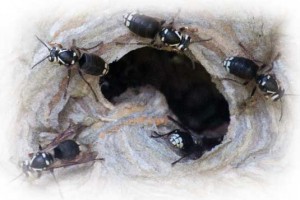Aerially articulate but potentially punitive, bald-faced hornets (Dolichovespula maculate) build abodes that can result in attacks on victims deemed too close for comfort.
Description: Workers are 0.5 to 0.625 in.; queens are 0.75 in. The head is much shorter than it is wide. The head to thorax and pedicel are equally constricted. The body is robust and features a short waist. Black and white patterns adorn the face, thorax, abdomen and first antennal segment of the male. The rear half of the abdomen features white markings. Wings are a smokey color.
Life Cycle: Complete metamorphosis. In the spring, females masticate wood to construct small, pendant-shaped nests of greyish pulp. The first generation is made only of female workers, which feed the successive larvae that independently close cells. The nest construction consists of many layers with an opening at the bottom. Males mature from unfertilized eggs; they mate and die. Young, mated females overwinter.
Habitat: These include wooded areas, trees, parks, gardens, shrubs, fences, outbuildings, attics and other secluded areas.
Food: This includes yellowjacket wasps, flies, sap and nectars. Many prey are captured in flight.
Range: Bald-faced hornets are found throughout North America.
Significance: They will defend their colony aggressively and are capable of attacks en masse, with individual wasps inflicting multiple stings.
Dr. Stuart Mitchell, D.O., Ph.D., M.P.H., B.C.E., a board-certified physician and entomologist, is principal technical specialist for PestWest Environmental, as well as PMP’s Technical Editor. He can be reached at docmitchell@northcoastmedia.net or 515-333-8923.

Leave A Comment